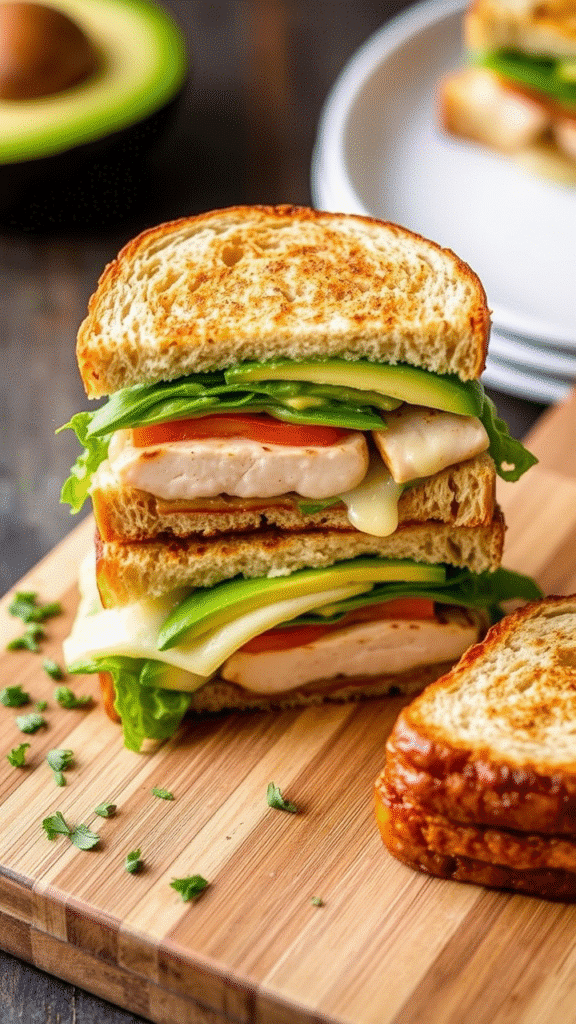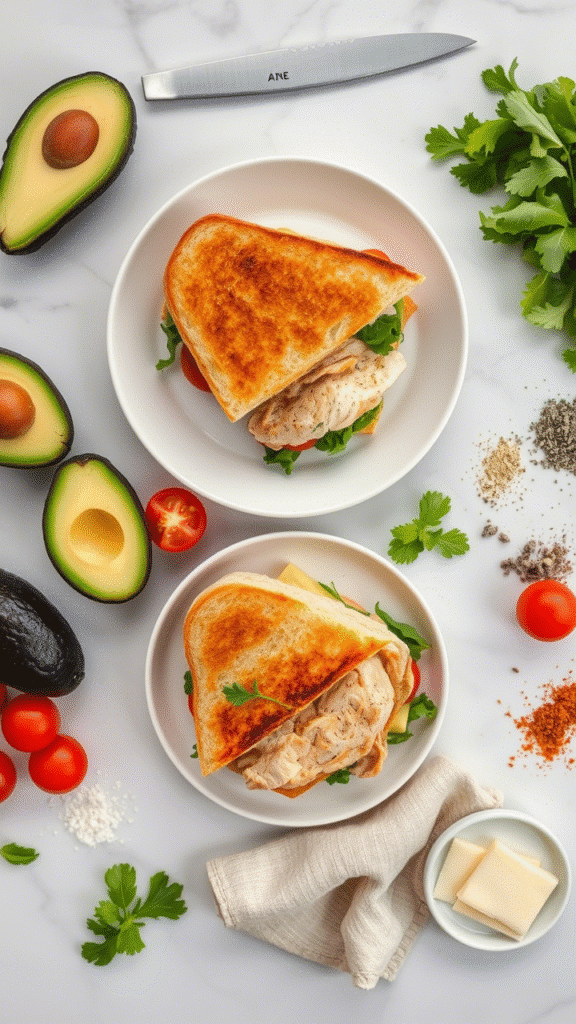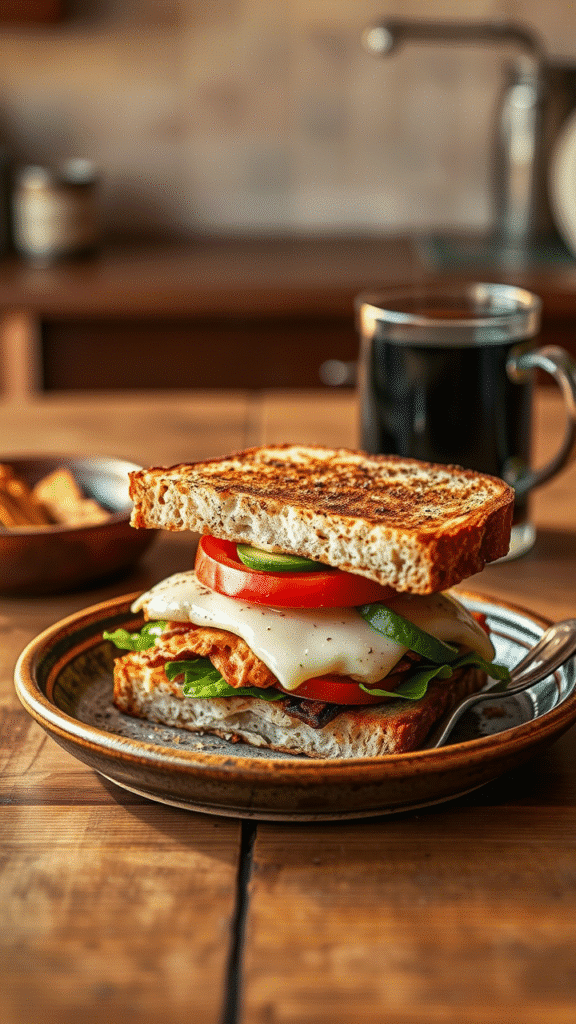The first time I truly understood the power of a well-crafted chicken avocado melt was during a particularly brutal lunch rush at a bistro in San Francisco. We’d run out of our signature paninis, and desperation led me to throw together what seemed like simple ingredients: leftover rotisserie chicken, perfectly ripe avocados, and some aged cheddar that was begging to be used. The result? A sandwich so devastatingly good that it became our most requested off-menu item within a week.
This isn’t just another sandwich recipe—it’s a masterclass in balancing textures, flavors, and temperatures that elevates humble ingredients into something transcendent. The chicken avocado melt represents the perfect marriage of protein-rich satisfaction and creamy indulgence, wrapped in the comforting embrace of toasted bread and melted cheese.
What makes this sandwich extraordinary is the interplay between the warm, savory chicken and the cool, buttery avocado, all bound together by molten cheese that acts as both flavor enhancer and textural bridge. It’s a symphony of contrasts that somehow creates perfect harmony on your palate.
Ingredients & Substitutions
Primary Ingredients
For the Chicken:
- 2 large boneless, skinless chicken breasts (about 1.5 lbs)
- 2 tablespoons olive oil
- 1 teaspoon garlic powder
- 1 teaspoon smoked paprika
- 1/2 teaspoon dried oregano
- Salt and freshly cracked black pepper to taste
For the Sandwich Assembly:
- 8 slices of sourdough bread (or artisanal whole grain)
- 2 large ripe avocados (Hass variety preferred)
- 8 oz sharp cheddar cheese, sliced thick
- 4 tablespoons butter, softened
- 2 tablespoons mayonnaise
- 1 medium tomato, sliced 1/4-inch thick
- 4 leaves of butter lettuce
- 1 small red onion, thinly sliced (optional)
The magic begins with ingredient selection, and here’s where many home cooks go wrong. Your chicken should be organic, free-range if possible—the difference in flavor and texture is remarkable. I’ve found that air-chilled chicken has better moisture retention than water-chilled varieties, which means juicier results.
For the avocados, timing is everything. They should yield slightly to gentle pressure but not be mushy. A perfectly ripe avocado will have dark, pebbly skin and feel substantial in your hand. If your avocados are too firm, place them in a paper bag with a banana overnight—the ethylene gas will work its magic.
Smart Substitutions
Protein Alternatives:
- Leftover rotisserie chicken (shredded, about 3 cups)
- Turkey breast, sliced thick
- Grilled portobello mushrooms for vegetarians
- Pulled pork for a heartier variation
Bread Options:
- Ciabatta for extra crunch
- Brioche for richness
- Multigrain for nuttiness
- Gluten-free bread for dietary restrictions
Cheese Variations:
- Gruyère for sophistication
- Pepper jack for heat
- Goat cheese for tanginess
- Vegan cheese for plant-based diets
The key to successful substitutions is understanding the role each ingredient plays. The chicken provides protein and umami, the avocado adds creaminess and healthy fats, and the cheese brings saltiness and binding properties. Whatever substitutions you make, ensure they fulfill these same functions.
Step-by-Step Instructions

Preparing the Chicken
Start by bringing your chicken to room temperature—this ensures even cooking and prevents the dreaded rubbery texture that plagues so many home-cooked proteins. Pat the breasts completely dry with paper towels; moisture is the enemy of proper searing.
Season generously with salt and pepper, then dust with garlic powder, smoked paprika, and oregano. The smoked paprika isn’t just for flavor—it creates that beautiful golden-brown color that makes your sandwich Instagram-worthy. Let the seasoned chicken rest for at least 15 minutes to allow the salt to penetrate the meat.
Heat a heavy-bottomed skillet or cast-iron pan over medium-high heat. Add olive oil and let it shimmer—this visual cue tells you the pan is ready. Place the chicken breasts in the pan and resist the urge to move them. Let them sear undisturbed for 6-7 minutes until a golden crust forms.
Flip once and cook for another 5-6 minutes, or until the internal temperature reaches 165°F. This is non-negotiable—undercooked chicken is dangerous, while overcooked chicken is cardboard. Use a meat thermometer; guessing is for amateurs.
Remove the chicken and let it rest for 5 minutes before slicing. This resting period allows the juices to redistribute throughout the meat, ensuring every bite is succulent. Slice against the grain at a slight angle for maximum tenderness.
Assembling the Perfect Melt
While the chicken rests, prepare your avocados. Cut them in half, remove the pit, and slice them directly in the skin before scooping out with a spoon. This technique gives you uniform slices without the mess. Immediately drizzle with a touch of lemon juice to prevent browning—oxidation is the enemy of beautiful food.
Butter one side of each bread slice generously. This isn’t the time to be stingy—the butter creates that golden, crispy exterior that makes a grilled sandwich irresistible. The buttered side will face outward during cooking.
On the unbuttered side of four bread slices, spread a thin layer of mayonnaise. This acts as a moisture barrier and adds richness. Layer the sliced chicken, followed by the avocado slices, tomato, and lettuce. Season the tomato with a pinch of salt and pepper—this small step amplifies its flavor dramatically.
Top with cheese slices, ensuring they extend slightly beyond the edges of the bread. As the cheese melts, it will create a delicious crispy edge that adds textural contrast. Cap with the remaining bread slices, buttered side facing out.
The Melting Process
Heat a large skillet or griddle over medium-low heat. This is crucial—too high and you’ll burn the bread before the cheese melts. Place the sandwiches in the pan and cook for 3-4 minutes per side, pressing gently with a spatula to ensure even contact with the cooking surface.
Watch for the telltale signs of perfection: the bread should be golden brown and crispy, while the cheese should be completely melted and starting to ooze slightly from the edges. If the bread is browning too quickly, reduce the heat further.
The sandwich is done when you can see melted cheese beginning to escape from the sides and the bread sounds hollow when tapped with a spatula. This auditory cue indicates the interior is properly heated through.
Cooking Techniques & Science

The Science of Searing
Proper searing isn’t just about color—it’s about flavor development through the Maillard reaction. This chemical process occurs when proteins and sugars are exposed to high heat, creating hundreds of new flavor compounds that give seared meat its distinctive taste and aroma.
The key is starting with a hot pan and dry protein. Any moisture on the chicken’s surface will steam rather than sear, preventing proper browning. Pat the chicken dry, season it, and let it come to room temperature before cooking.
Understanding Avocado Ripeness
Avocados contain enzymes that break down their cell walls as they ripen, transforming the firm, bitter fruit into the creamy, nutty delicacy we love. The optimal ripeness for sandwiches is when the avocado yields to gentle pressure but still holds its shape when sliced.
The Melting Point of Cheese
Different cheeses have different melting points and behaviors. Cheddar melts at around 150°F, creating a smooth, creamy texture. Aged cheddars have less moisture and more concentrated flavor, making them ideal for melts where you want bold cheese flavor without excessive greasiness.
Bread Selection Science
The choice of bread affects both texture and flavor. Sourdough’s acidity complements the richness of the avocado and cheese, while its sturdy structure prevents sogginess. The fermentation process also creates complex flavors that enhance the overall sandwich experience.
Common Mistakes and How to Avoid Them
The Overcooked Chicken Trap
Many home cooks overcook chicken breast, resulting in dry, stringy meat. Use a meat thermometer and remove the chicken at exactly 165°F. The residual heat will finish the cooking process during the resting period.
The Soggy Sandwich Syndrome
Moisture is the enemy of a good grilled sandwich. Pat ingredients dry, use a moisture barrier like mayonnaise, and avoid adding wet vegetables like pickles directly to the sandwich. If you must include juicy elements, pat them dry first.
The Uneven Melt Dilemma
Cheese melts from the outside in, so thick slices in the center may remain cold while the edges burn. Use thinner, more evenly distributed cheese slices, and cook over medium-low heat to allow the interior to warm through.
Serving & Pairing Suggestions

Presentation Perfection
Cut the sandwich diagonally to showcase the beautiful layers inside. The diagonal cut also makes the sandwich easier to eat and creates more surface area for melted cheese to ooze appealingly.
Serve immediately while the bread is still crispy and the cheese is molten. The contrast between the warm sandwich and a cool side creates an ideal eating experience.
Complementary Pairings
Sides:
- Crispy sweet potato fries for sweetness contrast
- Pickle spears for acidic brightness
- Coleslaw for crunch and freshness
- Tomato soup for the ultimate comfort food combination
Beverages:
- Craft beer with citrus notes
- Iced tea with lemon
- Fresh lemonade
- Light white wine like Sauvignon Blanc
Seasonal Variations
Summer: Add fresh basil and heirloom tomatoes Fall: Include roasted butternut squash and sage Winter: Incorporate roasted red peppers and arugula Spring: Fresh pea shoots and lemon zest
Advanced Techniques for the Ambitious Cook
Compound Butter Enhancement
Create a compound butter by mixing softened butter with minced garlic, herbs, and a pinch of salt. This elevates the exterior crust and adds another layer of flavor complexity.
Homemade Aioli
Replace plain mayonnaise with garlic aioli made from scratch. Whisk egg yolks with lemon juice, then slowly drizzle in olive oil while whisking constantly. The result is a richer, more flavorful spread that complements the other ingredients beautifully.
Cheese Blending
Experiment with cheese combinations—try mixing sharp cheddar with a small amount of cream cheese for extra richness, or blend different aged cheddars for complexity.
Troubleshooting Guide
Bread Burns Before Cheese Melts
Lower your heat to medium-low and consider covering the pan with a lid for the last minute of cooking to trap heat and encourage melting.
Avocado Turns Brown
This is oxidation. Prevent it by adding lemon juice immediately after slicing, or prepare avocados just before assembling the sandwich.
Chicken Seems Dry
This usually means overcooking. Next time, use a meat thermometer and consider brining the chicken for 30 minutes before cooking for extra moisture retention.
Sandwich Falls Apart
Ensure your bread isn’t too thick, and don’t overfill the sandwich. Press gently while cooking to help everything meld together.
The Final Word
The chicken avocado melt isn’t just a sandwich—it’s a study in balance, technique, and timing. When executed properly, it delivers comfort food satisfaction with gourmet sensibilities. The key lies in respecting each ingredient, understanding their individual contributions, and bringing them together with skill and care.
Remember that cooking is both science and art. Follow the techniques, but don’t be afraid to make it your own. Maybe you prefer a touch of sriracha for heat, or perhaps some crispy bacon for extra indulgence. The foundation is solid; the variations are endless.
This sandwich has the power to transform a simple lunch into a memorable meal. It’s comfort food that doesn’t compromise on sophistication, and simplicity that doesn’t sacrifice flavor. In a world of complicated recipes and exotic ingredients, sometimes the most profound pleasure comes from doing simple things extraordinarily well.
Frequently Asked Questions?
Can I make this sandwich ahead of time?
While the components can be prepped in advance, the sandwich should be assembled and cooked fresh. You can cook the chicken up to 24 hours ahead and store it refrigerated, and you can slice the avocado up to 4 hours ahead if you toss it with lemon juice and store it covered. However, the bread will become soggy if assembled too far in advance, and the cheese won’t melt properly if the sandwich is too cold when cooking.
What’s the best way to reheat leftover chicken for this sandwich?
Never microwave your leftover chicken—it will become rubbery and dry. Instead, slice it thinly and warm it gently in a skillet with a splash of chicken broth or white wine. This rehydrates the meat while bringing it to the perfect temperature for the sandwich. Alternatively, you can warm it in a 300°F oven wrapped in foil for about 10 minutes.
How do I keep the avocado from making the sandwich soggy?
The key is proper preparation and assembly order. First, ensure your avocado slices aren’t too thick—about 1/4 inch is ideal. Pat them dry with paper towels if they seem particularly moist. Use mayo as a moisture barrier on the bread, and assemble the sandwich just before cooking. If you’re concerned about excess moisture, you can lightly salt the avocado slices and let them drain on paper towels for 5 minutes before assembling.
Can I use a panini press instead of a skillet?
Absolutely! A panini press actually works exceptionally well for this sandwich. Preheat the press to medium heat, and cook for 3-4 minutes or until the bread is golden and the cheese is melted. The even pressure helps meld all the flavors together beautifully. Just be careful not to overstuff the sandwich, as the press will compress everything significantly.
What’s the secret to getting the cheese perfectly melted without burning the bread?
The secret is temperature control and patience. Use medium-low heat rather than high heat, and consider covering the pan with a lid for the last minute of cooking on each side. This creates a mini-oven effect that melts the cheese thoroughly while preventing the bread from burning. If your bread is browning too quickly, reduce the heat further—a perfectly melted cheese is worth the extra cooking time.

Veronica is a passionate food enthusiast with over three years of experience in exploring and writing about diverse cuisines. Her expertise lies in reviewing restaurants, sharing creative recipes, and discovering the latest food trends. As the voice behind FoodieRecap.com, Anju brings fresh perspectives and culinary insights to her audience.
